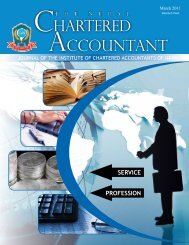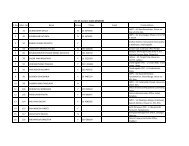INTERNATIONAL STANDARD ON AUDITING 720
INTERNATIONAL STANDARD ON AUDITING 720
INTERNATIONAL STANDARD ON AUDITING 720
Create successful ePaper yourself
Turn your PDF publications into a flip-book with our unique Google optimized e-Paper software.
7. An entity ordinarily issues on an annual basis a document which includes its<br />
audited financial statements together with the auditor’s report thereon. This<br />
document is frequently referred to as the “annual report.” In issuing such a<br />
document, an entity may also include, either by law or custom, other financial and<br />
non-financial information. For the purpose of this NSA, such other financial and<br />
non-financial information is called “other information.”<br />
8. Examples of other information include a report by management or the board of<br />
directors on operations, financial summaries or highlights, employment data,<br />
planned capital expenditures, financial ratios, names of officers and directors and<br />
selected quarterly data.<br />
9. In certain circumstances, the auditor has a statutory or contractual obligation to<br />
report specifically on other information. In other circumstances, the auditor has no<br />
such obligation. However, the auditor needs to give consideration to such other<br />
information when issuing a report on the financial statements, as the credibility of<br />
the audited financial statements may be undermined by inconsistencies which<br />
may exist between the audited financial statements and other information.<br />
10. Some jurisdictions require the auditor to apply specific procedures to certain of<br />
the other information, for example, required supplementary data and interim<br />
financial information. If such other information is omitted or contains<br />
deficiencies, the auditor may be required to refer to the matter in the auditor’s<br />
report.<br />
11. When there is an obligation to report specifically on other information, the<br />
auditor’s responsibilities are determined by the nature of the engagement and by<br />
legislation and professional standards. When such responsibilities involve the<br />
review of other information, the auditor will need to follow the guidance on<br />
review engagements in the appropriate NSAs.<br />
<strong>AUDITING</strong><br />
Access to Other Information<br />
12. In order that an auditor can consider other information included in the annual<br />
report, timely access to such information will be required. The auditor therefore<br />
needs to make appropriate arrangements with the entity to obtain such<br />
information prior to the date of the auditor’s report. In certain circumstances, all<br />
the other information may not be available prior to such date. In these<br />
circumstances, the auditor would follow the guidance in paragraphs 23-26.<br />
Consideration of Other Information<br />
13. The objective and scope of an audit of financial statements are formulated on the<br />
premise that the auditor’s responsibility is restricted to information identified in<br />
the auditor’s report. Accordingly, the auditor has no specific responsibility to<br />
determine that other information is properly stated.<br />
NSA 22/final 2




